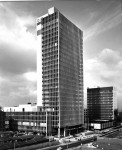A very modern magazine
Article published: Wednesday, June 22nd 2011
Thursday sees the launch of a new Manchester publication. The Modernist published by the Manchester Modernist Society aims to promote iconic buildings from around the North West and the ideals that gave birth to an architectural aesthetic and vision now on the wane. Tim Hunt caught up with one of its founders Jack Hale to find out more.
 Jack and I have known each other for a while (our partners work together) and whenever we meet I can’t help but be inspired by his enthusiasm for architecture, particularly for modernism with all its progressive ideals. He’s made me look at Manchester and its buildings in a whole new light so when I found out he was releasing a new magazine I thought it would be the ideal opportunity to try and impart some of his zest for an egalitarian built environment on MULE readers.
Jack and I have known each other for a while (our partners work together) and whenever we meet I can’t help but be inspired by his enthusiasm for architecture, particularly for modernism with all its progressive ideals. He’s made me look at Manchester and its buildings in a whole new light so when I found out he was releasing a new magazine I thought it would be the ideal opportunity to try and impart some of his zest for an egalitarian built environment on MULE readers.
We meet in Kim by the Sea an apt place for a meeting with an arch modernist and architectural enthusiast. The building, often lauded for its design, houses the quaint cafe is possibly the most egalitarian in Manchester, operating as a housing co-op and home to a number of social enterprises.
I begin by asking Jack to define modernism, a concept that to many now seems rather passée.
“In architectural terms it is a particular style and ethos developed in the 20th Century that was basically meant to eschew the styles of the past, to be innovative and new, and experiment with new materials. It aimed to look forward and look to the future,” he says. “So they always used what were then contemporary, like concrete and glass and there was no or minimal decoration, because it didn’t do anything for the structure of the building. It follows the old adage form follows function.”
The idea of modernism, he tells me, originated in continental Europe and developed through the Bauhaus school in Germany and an architect named Le Corbusier in France before being introduced into England in the late 1920s.
But far from being just an engineering and aesthetic movement it was also a political movement. “Essentially it had socialist aims of improving peoples lives through architecture. It ultimately led on to the period of the welfare state and social housing,” says Jack, “so some of our reasons for promoting it as a cause are social as well as architectural. Modernism was essentially a social movement.”
However Jack doesn’t see it as just a thing of the past. “We are promoting it as an ongoing thing,” he tells me. “You could define it as a historic period in architectural but there is no reason that it can’t continue just because it has gone out of fashion politically or aesthetically.”
This seems particularly important in Manchester where yuppie flats are (or were) thrown up at a colossal rate while council housing (an idea born of the modernist era) disappears and the social housing waiting list tops 20,000.
Jack is a firm believer in the ideal and the notion that progressive nature of the modernist project can still be relevant today. He says there can be “20th century modernism” but feels that the fundamentals are being lost to the free market.
“There are many new buildings that look modernist, but we live in a society that is much more led by the market forces. The kind of planning (political, social and town) that might of existed in the 1940s doesn’t really exist any more so that’s why that sort of modernism is in the past. Politically we don’t think in those terms anymore.”
He still believes though that the importance of the modernist era shouldn’t be underestimated, especially in the way it has shaped Manchester. “It’s shaped the city in the same way as its shaped nearly all British modern industrial cities. A lot of the schools, hospitals, clinics and all of the social housing was hugely influenced by modernism so it’s shaped those aspects of the built environment.”
But to Jack much of this is missed by the council and in the way Manchester is marketed. “It’s very much based on Manchester being a Victorian city. We hark back in a romantic way to what we now think of as beautiful buildings , the mills and the Town Hall, forgetting the horrors that they housed, the condition of the workers. 20 or 30 years ago no one thought they were beautiful. ‘Victorian monstrosities’ was a common phrase, they were dirty and falling down and crumbling, and no one could think of any use for them.
“This is generally what is happening to 20th century buildings now. We are not just about campaigning to save them but if they are all pulled down there will be a huge gap in the histories of cities as you’ll leap from Victorian to 21st century. Howard Bernstein is famously not interested in conservation.”
And this neglect is worsening the situation for many buildings that could be reused. “A wide perception is that they are ugly and therefore they are left to crumble and fall down. And the more neglected they are the more difficult it is for many people to see that there is a new or a different or future use for them.”
A good example of this is Elizabeth House on St Peters Square – previously home of the Dutch Pancake House. It’s a building that Jack admires despite its current appearance: “I like it, it’s a great shape, it’s multi-layered and shaped with odd angles to it. But it’s empty and dirty and it’s boarded up so it’s very easy to think that it can’t be bought back to life.
“It’s almost certain that it’s going to be bought down,” he adds with an air of resignation, “all the plans have been approved and it will probably be replaced by a very boring black box.”
According to Jack though the crisis in capitalism and the resultant crash in the building industry has offered a reprieve for many modernist buildings. Gateway House on the Piccadilly approach leading to the train station and Manchester House in Spinningfields are two examples. Others have recently won some leeway after being earmarked for demolition.
The new magazine aims to build on this opportunity. Focusing on Modernism in the North West the publication is not so much a call to arms but a call to appreciate and acknowledge the role that Modernism has played in the past and could still play in the future.
The first issue has articles on Liverpool, the recently closed Blackburn Market and the big industrial structures like the old cooling towers.
“We ask the question shouldn’t people appreciate them? They are magnificent structures. The author suggests that if they were in a desert they would be world monuments, so awe-inspiring and brilliantly engineered that they are worth looking at and thinking about again.”
![The-Modernist-[Bold]-Coverforweb](http://manchestermule.com/wp-content/uploads/2011/06/The-Modernist-Bold-Coverforweb-115x150.png) The Modernist will launch as part of the Architecture Festival 2011 at CUBE Gallery 6.30pm – 8.30pm on Thursday. CUBE, 113 – 115 Portland Street
Manchester
M1 6DW
The Modernist will launch as part of the Architecture Festival 2011 at CUBE Gallery 6.30pm – 8.30pm on Thursday. CUBE, 113 – 115 Portland Street
Manchester
M1 6DW
The event will also give people the opportunity to see the Manchester Modernist Society’s new multimedia mapping project. In association with the University of Salford, MMS have devised an online map/archive of 20th century buildings for Greater Manchester, which there is the opportunity to explore and add some of your own.
The magazine will also be available from the Manchester Modernist Society website, From the Cube bookshop and the Cornerhouse cinema on Oxford Road.
Comments
-
Jack says of Elizabeth House
‘It’s almost certain that it’s going to be bought down,” he adds with an air of resignation, “all the plans have been approved and it will probably be replaced by a very boring black box.’
It could be worse. It might be replaced by some toytown, faddish and self-indulgent building like the filing cabinet building near Deansgate or the war museum in Trafford.
Comment by simon on June 22, 2011 at 11:29 am -
Tim Hunt is my hero!
Comment by Chris Russell on August 29, 2011 at 4:03 pm
The comments are closed.



